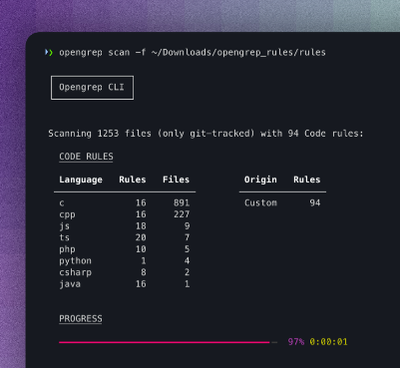
Security News
Opengrep Emerges as Open Source Alternative Amid Semgrep Licensing Controversy
Opengrep forks Semgrep to preserve open source SAST in response to controversial licensing changes.
dash_progress_bar
Advanced tools
dash-progress-bar is a Dash component library.
Get started with:
python usage.pySee CONTRIBUTING.md
If you have selected install_dependencies during the prompt, you can skip this part.
Install npm packages
$ npm install
Create a virtual env and activate.
$ virtualenv venv
$ . venv/bin/activate
Note: venv\Scripts\activate for windows
Install python packages required to build components.
$ pip install -r requirements.txt
Install the python packages for testing (optional)
$ pip install -r tests/requirements.txt
src/lib/components/LineProgressBarComponent.react.js.src/demo and you will import your example component code into your demo app.$ npm run build:all
usage.py sample dash app:
$ python usage.py
tests/test_usage.py, it will load usage.py and you can then automate interactions with selenium.$ pytest tests.dash_progress_bar).
MANIFEST.in so that they get properly included when you're ready to publish your component._css_dist dict in dash_progress_bar/__init__.py so dash will serve them automatically when the component suite is requested.Build your code:
$ npm run build:all
Create a Python tarball
$ python setup.py sdist
This distribution tarball will get generated in the dist/ folder
Test your tarball by copying it into a new environment and installing it locally:
$ pip install dash_progress_bar-0.0.1.tar.gz
If it works, then you can publish the component to NPM and PyPI:
$ rm -rf dist
$ twine upload dist/*
publish_on_npm)
$ npm publish
serve_locally flags to True (unless you choose False on publish_on_npm). We will eventually make serve_locally=True the default, follow our progress in this issue.Share your component with the community! https://community.plot.ly/c/dash
FAQs
Project Description
The npm package dash_progress_bar receives a total of 2 weekly downloads. As such, dash_progress_bar popularity was classified as not popular.
We found that dash_progress_bar demonstrated a not healthy version release cadence and project activity because the last version was released a year ago. It has 1 open source maintainer collaborating on the project.
Did you know?

Socket for GitHub automatically highlights issues in each pull request and monitors the health of all your open source dependencies. Discover the contents of your packages and block harmful activity before you install or update your dependencies.

Security News
Opengrep forks Semgrep to preserve open source SAST in response to controversial licensing changes.

Security News
Critics call the Node.js EOL CVE a misuse of the system, sparking debate over CVE standards and the growing noise in vulnerability databases.

Security News
cURL and Go security teams are publicly rejecting CVSS as flawed for assessing vulnerabilities and are calling for more accurate, context-aware approaches.